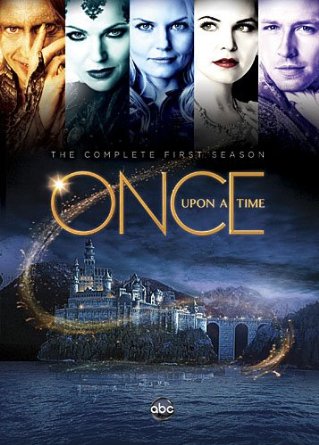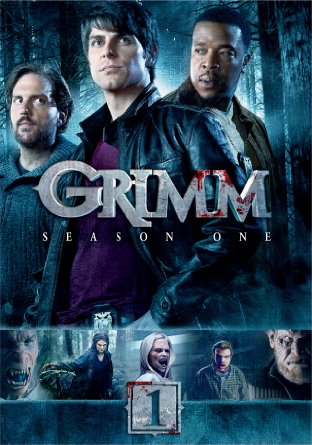Fairy Tale TV Shows
Reviewed by Harley J. Sims
[This review originally appeared in Mythprint 48:11 (#352) in November 2011.]
Treading Water in the Ocean of Story
Fantasy has returned to primetime network television, and twice in one week. October 23rd saw the debut of ABC’s Once Upon a Time, a family-oriented dramatic series about fairytale figures trapped in a world where there are no happy endings—our own. The villain responsible for their exile is none other than the evil queen of Snow White and the Seven Dwarfs, who will face off against the adult daughter of her nemesis in the small town of Storybrooke, Maine. On October 28th, NBC responded with Grimm, a dark, crime-oriented drama about one of the last descendants of the Brothers Grimm. Like his ancestors are revealed to have been, Oregon homicide detective Nick Burkhardt discovers he has the ability to detect supernatural monsters hiding among, and as, every-day people. Both Grimm and Once Upon a Time are big-budget, well-performed, and penned by established screenwriters; scribes from Buffy the Vampire Slayer are responsible for the former, while Once Up-on a Time is the brainchild of Lost writers Adam Horowitz and Edward Kitsis. Before fairy-tale fans rejoice, however, they should consider some of the storytelling conventions already governing the two productions, in particular the arbitrary and unregulated use of their traditional sources.
Though generically and structurally distinct as narratives, both Once Upon a Time and Grimm are franchises of allusion, with European fairytales providing the elements of which they are built. Allusiveness is not in itself disconcerting; most fictive narratives refer to or imply material beyond their own structures. What makes the use of allusion disconcerting in Once Upon a Time and Grimm is a number of things, foremost being that the material alluded to is itself fictive. They are thus fiction built out of fiction, stories built out of stories, and not one story, but an indefinite number of tales—unstable for their oral basis—all blended into a shared world that, in Once Upon a Time at least, forms a backstory and an otherworld that is already a fiction formed of fiction. Prince Charming’s War Council is composed of the protagonists of numerous fairytales, as well as their allies (Red Riding Hood, Pinocchio, etc.), all cohabiting and cooperating in a way that begs an in-exhaustible number of questions, and which the writers will be only too happy to address, answer, and re-answer as it suits them. It seems ridiculous that Gran-ny from Red Riding Hood sits on a War Council alongside Gepetto and other domestic figures, suggesting that generic forces have subsumed the identities of these characters utterly. Done patiently, it could have been reminiscent of Michael Ende’s Neverending Story, where the denizens of Fantasia gather at the palace of the Childlike Empress to ad-dress the threat of the Nothing. Instead, it comes across much like one of Square-Enix’s Kingdom Hearts video games, where Disney characters on both sides have joined forces in a war of annihilation, and we get to see the Little Mermaid punching and tail-slapping her way to a happy ending.
It’s certainly a spin, but such innovation is also a trapdoor into a labyrinthine house of mirrors. In the first episode of Once Upon a Time, Snow White’s modern alter ego, Mary Margaret Blanchford, refers to “the classics; there’s a reason why we all know them.” This is curious coming from a character clear-ly based on the Disney version of the princess, and not on the Sneewitchen of the Grimms’ Kinder- und Hausmärchen. It may sound pedantic with Snow White, but in Once Upon a Time, you will not only find the dwarfs with their Disneyfied Care Bear names and personas (Sleepy, Grumpy, Happy, etc.), but also Jiminy Cricket, Maleficent, and several others; Disney has apparently given the show license to use these characters—their versions of the literary originals—which establishes yet another layer of fiction, of uncertainty, for the writers to exploit. In Grimm, the use of traditional material is almost like a jilting, where the fairytales of the Brothers Grimm are courted by the writers to create a reality, and are then discredited within the conditions of that reality as distortions and half-truths. Neil Gaiman and Roger Avary did the same thing in writing Robert Zemeckis’s Beowulf film, and it is all very postmodern.
Though the pilot episode of Grimm is premised on “Little Red Riding Hood” (a fairytale by Charles Perrault, not the Brothers Grimm) the first ‘big bad wolf’ we really meet is a good guy who has managed to suppress his bloodthirsty nature, and who tells the protagonist, “you people started profiling us two hundred years ago … we’re not things.” Some of the traditional lore about wolfmen—like wolfsbane—turns out to have a some sort of effect on the creatures, but when the protagonist asks if killing one of them needs “something like silver bullets,” the wolfman replies, “what are you? An idiot?” It’s pick-and-choose, bait-and-switch allusiveness at its worst; at the same time as the series relies on recognizable themes and characters, nothing the audience already knows about them is operative unless the writers authorize it. What’s more is that the continuing series Supernatural has already done this sort of thing for seven seasons, not to mention dozens of other series, films, literary works, and games both electronic and tabletop. These shows are to fairytale aficionados what the series Heroes was to X-Men fans; they will appeal to new or casual audiences, but to established interests will seem derivative to the point of parasitism.
Despite Snow White’s suggestion that we all know the classics, it has been nearly twenty-five years since Shelley Duvall’s Faerie Tale Theater last appeared on primetime television. Even so, many of these tales were subjected to Hollywood spin, some of them intolerably. Disney films, though undeniably clever and entertaining, are likewise distortions. It remains unclear where exactly mainstream modern audiences are supposed to have learned the classics, with children’s books increasingly bowdlerized to remove violence and conflict. Mary Engelbreit’s Nursery Tales has a Gingerbread Boy who doesn’t get eaten, for example, and the wolf manages to escape his traditional comeuppance in both “Little Red Riding Hood” and “The Three Little Pigs.” In Grimm and Once Upon a Time, there is no effort to establish the backstories upon which the front stories are projected, and from which they draw all of their prestige and appeal. With modern serial storytelling, this is both deliberate and essential, where the engine, materials, and direction of the story are all premised on indeterminacy, where it is far more important to avoid definition than it is to establish it. Those who followed the series Lost were subjected to this sort of narrative, where multiple timelines (some speculative), a reservoir of characters, a wandering point of view, and an unclear purpose left audiences to be baited and led week after week, year after year, until the creators finally put a bullet in them. Once Upon a Time, should it last, will be much worse, simply because it of its allusive basis. The second episode of Grimm, meanwhile, is based on “The Story of the Three Bears,” which still isn’t a Grimm fairytale.
What is certain with these series is that Holly-wood will do what it does best—indulging in sadistic, psychological painfests and zooming in on the reactions to them. “You know what sucks?” Emma Swan of Once Upon a Time asks the ten year-old son she gave up for adoption. “My parents abandoned me on the side of a highway. They didn’t even drive me to the hospital.” Call it hurt-trumping, or the oneupmanship of suffering; either way, it’s the chlorophyll of postmodernism’s interpersonal ivy. Mary McNamara of the LA Times titled her review of the two shows, “Fairy tales all grown up.” Taking things that work and breaking them apart … sounds kind of childish, really.
Once Upon A Time. ABC.
Grimm. NBC.



